Are you fascinated by Vietnamese history and culture and planning a trip to explore the ancient capital of Hoa Lu? The Dinh and Early Le Dynasties, deeply rooted in Hoa Lu, significantly shaped Vietnam’s rich heritage and culture. Let SIXT.VN be your guide to Vietnam’s historical treasures and discover the convenience of our airport transfer, hotel booking, and tour services for an unforgettable journey. Uncover historical landmarks, cultural immersion, and heritage tourism like never before.
1. What Dynasties Established Their Capitals in Hoa Lu?
The Dinh and Early Le Dynasties established their capitals in Hoa Lu. These two dynasties played pivotal roles in shaping Vietnam’s history and culture, marking Hoa Lu as a significant historical site. Hoa Lu served as the capital of Vietnam from 968 to 1010, under the Dinh and Early Le Dynasties. Emperor Dinh Tien Hoang (whose real name was Dinh Bo Linh) founded the Dinh Dynasty in 968 and chose Hoa Lu as his capital. After Dinh Bo Linh’s assassination, Le Hoan seized power and established the Early Le Dynasty in 980, continuing to use Hoa Lu as the capital.
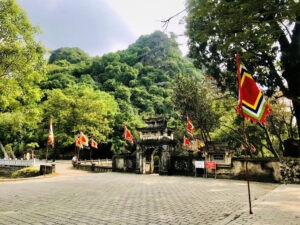 Dinh king temple
Dinh king temple
These dynasties were instrumental in establishing an independent Vietnamese state and laid the groundwork for future dynasties. Hoa Lu’s strategic location and natural defenses made it an ideal choice for a capital during a period of political instability and external threats. The Dinh and Early Le Dynasties are credited with centralizing power, developing a strong military, and promoting agriculture and trade, which contributed to the country’s prosperity.
2. Who Was Dinh Bo Linh?
Dinh Bo Linh, later known as Emperor Dinh Tien Hoang, was the founder of the Dinh Dynasty and the emperor who chose Hoa Lu as the capital of Vietnam in 968. He is revered as a national hero for unifying the country after a period of internal conflict known as the “Era of the 12 Warlords.” Dinh Bo Linh’s rise to power began in his childhood, where he gathered local children to play war games. Recognizing his leadership potential, people from his village supported him in battles against other warlords.
According to historical records, Dinh Bo Linh successfully quelled the rebellions of the 12 warlords and established the Dai Co Viet kingdom, marking the beginning of a centralized Vietnamese state. He implemented numerous reforms, including establishing a court system, standardizing weights and measures, and organizing the army. His leadership laid a strong foundation for Vietnam’s independence and development.
3. How Did Le Hoan Become Emperor?
Le Hoan, a military commander under the Dinh Dynasty, became Emperor Le Dai Hanh after the assassination of Dinh Bo Linh and his son. Recognizing the vulnerability of the Dinh Dynasty due to the young age of the designated heir, Le Hoan seized power with the support of the court and the military. His ascension to the throne marked the beginning of the Early Le Dynasty in 980.
Le Hoan proved to be a capable ruler, continuing many of Dinh Bo Linh’s policies and successfully defending the country against foreign invasions. He is particularly famous for his military prowess, leading the Vietnamese army to victory against the Song Dynasty of China in 981. Le Hoan’s reign solidified Vietnam’s independence and strengthened its position in the region.
4. What Is Dai Co Viet?
Dai Co Viet, meaning “Great Viet,” was the name of the Vietnamese state established by Emperor Dinh Tien Hoang in 968. This marked a significant turning point in Vietnamese history as it represented the re-establishment of an independent and centralized Vietnamese kingdom after centuries of Chinese rule. The name “Dai Co Viet” reflected the ambition and aspirations of the Vietnamese people to build a strong and prosperous nation.
Dai Co Viet encompassed present-day northern Vietnam and parts of central Vietnam. Under the Dinh and Early Le Dynasties, Dai Co Viet saw significant developments in agriculture, trade, and military organization. The establishment of Dai Co Viet laid the foundation for the development of Vietnamese national identity and culture.
5. What Is the Significance of Hoa Lu’s Location?
Hoa Lu’s location was strategically important for several reasons. Situated in a basin surrounded by limestone mountains and rivers, it provided natural defenses against invaders. The mountains offered protection from the north, while the rivers served as moats, making it difficult for enemies to attack.
The fertile plains around Hoa Lu also supported agriculture, allowing the population to thrive. The area was well-connected to other parts of the country through waterways, facilitating trade and communication. Hoa Lu’s strategic location contributed to its selection as the capital of the Dinh and Early Le Dynasties and played a crucial role in the defense and development of Dai Co Viet.
6. What Are the Key Features of the Dinh Tien Hoang Temple?
The Dinh Tien Hoang Temple, dedicated to Emperor Dinh Tien Hoang, is a significant historical and architectural site in Hoa Lu. The temple complex spans approximately 5 square kilometers and includes courtyards, gardens, and a lake. The architecture reflects traditional Vietnamese design, with intricate carvings and elaborate decorations.
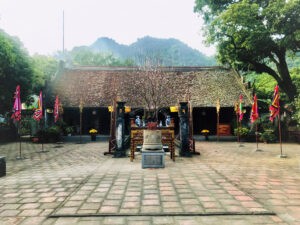 Thượng (Upper) temple courtyard
Thượng (Upper) temple courtyard
One of the notable features is the stone pillar at the entrance, inscribed with Chinese characters signifying the defeat of invaders from the North. The main building is divided into three sections: the Ceremonial rooms for general prayers, the Thien Huong dedicated to the four mandarins of the Dinh dynasty, and the innermost sanctum containing a bronze statue of Dinh Tien Hoang and altars to his sons. The Dinh Tien Hoang Temple stands as a testament to the legacy of the Dinh Dynasty and the reverence accorded to its founder.
7. What Are the Highlights of the Le Dai Hanh Temple?
The Le Dai Hanh Temple, dedicated to Emperor Le Dai Hanh, is located near the Dinh Tien Hoang Temple in Hoa Lu. Although smaller in size, it shares similar architectural features and historical significance. The temple’s design closely resembles that of the Dinh Tien Hoang Temple, reflecting the continuity between the Dinh and Early Le Dynasties.
A notable highlight is the small museum within the temple complex, which houses artifacts discovered during renovations. The centerpiece of the museum is a “statue” of Queen Duong Van Nga, who was the wife of both Emperors Dinh Tien Hoang and Le Dai Hanh and a revered figure in Vietnamese history. The Le Dai Hanh Temple provides insights into the Early Le Dynasty and its contributions to the development of Vietnam.
8. How Did Queen Duong Van Nga Influence Both Dynasties?
Queen Duong Van Nga played a unique role in Vietnamese history as she was the wife of both Emperor Dinh Tien Hoang of the Dinh Dynasty and Emperor Le Dai Hanh of the Early Le Dynasty. After the assassination of Dinh Tien Hoang, she made the decision to marry Le Hoan, which helped ensure the stability of the kingdom and the continuation of many of the Dinh Dynasty’s policies.
Her decision was crucial in preventing internal strife and external invasion, as Le Hoan was a capable military leader who could defend the country. Queen Duong Van Nga is revered for her wisdom and selflessness in putting the interests of the nation above personal considerations. She is remembered as a symbol of unity and continuity between the Dinh and Early Le Dynasties.
9. What Architectural Style Is Reflected in Both Temples?
Both the Dinh Tien Hoang Temple and the Le Dai Hanh Temple reflect the ancient architectural philosophy of Noi Cong (工) and Ngoai Quoc (国), meaning “domestic and foreign.” The internal building design is based on the Chinese character “工,” while the external landscaping and garden design emulate “国.” This architectural style is common in many ancient Vietnamese temples and pagodas in Hoa Lu.
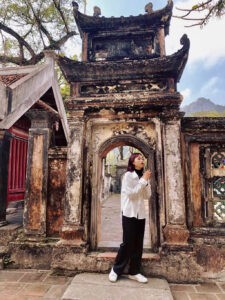 Entrance 2
Entrance 2
The use of this architectural style symbolizes the harmony between the internal structure and the external environment, reflecting the balance and order that the Dinh and Early Le Dynasties sought to establish in their kingdom. The intricate carvings, the layout of the courtyards, and the placement of the buildings all contribute to the overall aesthetic and symbolic significance of the temples.
10. How Can Visitors Respectfully Explore Truong Yen Village?
Truong Yen Village, located near the Dinh and Le Temples, is one of the oldest continually inhabited areas in Vietnam and offers visitors an opportunity to explore the spiritual and social history of Vietnam. When visiting Truong Yen Village, it is important to dress appropriately and behave respectfully, as the sites hold great religious and historical significance for the Vietnamese.
Visitors should wear modest clothing, avoiding revealing or disrespectful attire. It is also important to be mindful of local customs and traditions, such as removing shoes before entering temples and pagodas. Maintaining a quiet and respectful demeanor while exploring the village is essential to show reverence for the historical and religious significance of the sites.
11. What Events Occur During the Dinh-Le Temple Festival?
The Dinh-Le Temple Festival, held annually on the third new moon of the lunar calendar (usually around March), is a major cultural event in Hoa Lu. The festival commemorates the Dinh and Early Le Dynasties and celebrates the rich history and traditions of the region. During the festival, the Dinh-Le temples are the center of attraction, with various ceremonies, performances, and activities taking place.
The festival includes processions, traditional music and dance performances, and religious rituals. Local communities participate in games, contests, and cultural exhibitions. The Dinh-Le Temple Festival provides visitors with a unique opportunity to experience the vibrant culture and traditions of Hoa Lu and to pay homage to the historical figures who shaped Vietnam’s past.
12. What are Some Travel Tips for Visiting Hoa Lu?
When planning a trip to Hoa Lu, here are some helpful travel tips to enhance your experience:
- Transportation: Tours and taxis are familiar with Hoa Lu, the Dinh-Le Temple, and Truong Yen Village. The shortest route from Ninh Binh City to the temple complex is about 7km. Ride-sharing apps like Grab also provide fixed fares.
- Comfort: Wear comfortable shoes, as you will be doing a lot of walking.
- Essentials: Bring water and wear a hat to protect yourself from the sun.
- Navigation: For exploring more remote destinations, Google Maps and Translate can be helpful, but be aware that internet connectivity may be patchy in remote areas. Download maps to your phone beforehand.
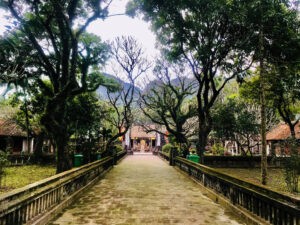 A corner of Dinh- Le temples
A corner of Dinh- Le temples
- Entrance Fees: Adults pay an entrance fee of 20,000 VND to enter the Dinh-Le Temple, and motorbike parking costs 20,000 VND per vehicle. Car parking ranges from 40,000 to 50,000 VND per vehicle.
- Respect: Dress modestly and behave respectfully when visiting temples and pagodas.
13. What Other Attractions Are Near the Dinh and Le Temples?
Besides the Dinh and Le Temples, Truong Yen Village offers several other attractions worth exploring. These include:
- Nhat Tru Pagoda: Showcases some of the oldest architecture in Vietnam.
- Princess Phat Kim Temple: Dedicated to the daughter of King Dinh Tien Hoang.
- Thien Ton Pagoda and Cave: A scenic and spiritual site.
- Am Tien Pagoda: A historical and religious site with beautiful landscapes.
These attractions provide additional insights into the history, culture, and spirituality of the region.
14. How Were the Temples Restored Over Time?
Throughout their history, the ancient temples honoring the founders of the Dinh and Le dynasties have faced damage and destruction due to wars, floods, typhoons, and vandalism. Originally constructed in the 11th century, the temples underwent considerable reconstruction, particularly during the late 1600s, and later in the 1700s and 1800s under the Later Le, the Tay Son, and Nguyen Dynasties.
Some of the restorations were significant. For instance, during the Later Le Dynasty, the temple’s original northern aspect was repositioned to face East. In 1898, the temple underwent a full restoration, leaving the Eastern aspect intact but remodeling the pillar rocks in the Nguyen Dynasty style and adding a stone threshold. These restorations have helped preserve the temples for future generations, while also reflecting the changing architectural styles and cultural influences over time.
15. How Did Hoa Lu Influence Southeast and Northern Asia?
The Dinh and Early Le Dynasties, based in Hoa Lu, played a significant role in shaping the political and cultural landscape of Southeast and Northern Asia. By establishing a strong and independent Vietnamese state, they influenced other nations in the region and asserted Vietnam’s position as a major player. The military victories of the Dinh and Early Le Dynasties, particularly against the Song Dynasty of China, demonstrated Vietnam’s ability to defend itself against foreign aggression.
The cultural and economic exchanges that took place during this period also contributed to the spread of Vietnamese influence in the region. The legacy of Hoa Lu as a center of power and innovation has had a lasting impact on the history and development of Vietnam and its relations with neighboring countries.
16. What Made Dinh Bo Linh an Effective Leader?
Dinh Bo Linh’s effectiveness as a leader stemmed from a combination of strategic vision, military prowess, and an ability to unite disparate factions under a common cause. His early recognition of the need to end the “Era of the 12 Warlords” showcased his insight into the political landscape of his time. By consolidating power and centralizing the government, Dinh Bo Linh laid a strong foundation for the Dinh Dynasty and the subsequent prosperity of Dai Co Viet.
His implementation of reforms, such as establishing a court system and standardizing weights and measures, further demonstrated his commitment to creating a well-organized and efficient state. Additionally, his ability to inspire loyalty and dedication among his followers played a crucial role in his success, as he was able to rally support from various segments of society to achieve his goals.
17. What Crucial Reforms Did Le Hoan Implement?
Le Hoan, upon ascending to the throne and establishing the Early Le Dynasty, implemented several crucial reforms that built upon the foundations laid by Dinh Bo Linh. Recognizing the importance of a strong military, Le Hoan focused on enhancing the capabilities of the Vietnamese army. This included modernizing military tactics, improving training, and ensuring a steady supply of resources for soldiers.
In addition to military reforms, Le Hoan also promoted agriculture and trade. He encouraged farmers to cultivate new lands and implemented policies to facilitate trade both domestically and internationally. These economic reforms contributed to the overall prosperity of Dai Co Viet and strengthened its position in the region.
18. How Did Hoa Lu’s Temples Differ from Others in Vietnam?
Hoa Lu’s temples, particularly the Dinh Tien Hoang Temple and the Le Dai Hanh Temple, differ from other temples in Vietnam due to their historical significance and architectural style. Unlike many other temples that are dedicated to Buddhist or Taoist deities, the temples in Hoa Lu are primarily dedicated to historical figures, specifically the emperors of the Dinh and Early Le Dynasties. This reflects the importance of ancestor worship and the reverence for national heroes in Vietnamese culture.
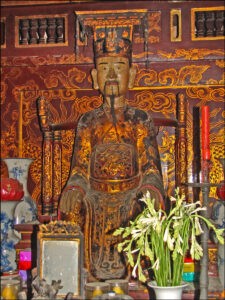 Dinh Bo Linh image at Dinh-Le Temple
Dinh Bo Linh image at Dinh-Le Temple
Additionally, the architectural style of the temples, with its emphasis on the Noi Cong (工) and Ngoai Quoc (国) philosophy, is unique to Hoa Lu and reflects the specific cultural and historical context of the region. The temples’ intricate carvings, elaborate decorations, and strategic layout all contribute to their distinct character and make them stand out among other temples in Vietnam.
19. What Role Did Confucianism Play During the Dinh Dynasty?
Confucianism played a significant role during the Dinh Dynasty, influencing various aspects of governance, education, and social norms. Emperor Dinh Tien Hoang recognized the value of Confucian principles in maintaining social order and promoting ethical behavior among his officials and subjects. Confucianism provided a framework for organizing the state and establishing a merit-based bureaucracy.
The establishment of the Thien Huong section in the Dinh Tien Hoang Temple, dedicated to the four mandarins of the Dinh Dynasty, reflects the Confucian emphasis on honoring virtuous officials and promoting good governance. Confucian ideals also influenced the education system, with the establishment of schools and academies to train scholars and officials in Confucian classics.
20. What are the 5 Intended Searches for “Which Dynasties Had Their Capitals At Hoa Lu? (Dinh and Early Le Dynasties)”?
- Historical Information: Users want to know which dynasties ruled from Hoa Lu and the historical context of that period.
- Biographies: Users are interested in learning about the key figures of the Dinh and Early Le Dynasties, such as Dinh Bo Linh and Le Hoan.
- Tourist Information: Users are planning a trip to Hoa Lu and want to know what attractions to visit and what to expect.
- Cultural Significance: Users want to understand the cultural and historical importance of Hoa Lu and its temples.
- Architectural Details: Users are curious about the architectural styles of the temples and other structures in Hoa Lu.
21. FAQ About Hoa Lu and Its Dynasties
21.1. When was Hoa Lu the capital of Vietnam?
Hoa Lu was the capital of Vietnam from 968 to 1010, during the Dinh and Early Le Dynasties.
21.2. Who founded the Dinh Dynasty?
Dinh Bo Linh, later known as Emperor Dinh Tien Hoang, founded the Dinh Dynasty in 968.
21.3. How did Le Hoan become the emperor of the Early Le Dynasty?
Le Hoan, a military commander under the Dinh Dynasty, seized power after the assassination of Dinh Bo Linh and established the Early Le Dynasty in 980.
21.4. What is Dai Co Viet?
Dai Co Viet, meaning “Great Viet,” was the name of the Vietnamese state established by Emperor Dinh Tien Hoang in 968.
21.5. Why was Hoa Lu chosen as the capital?
Hoa Lu’s location was strategically important due to its natural defenses, fertile plains, and good connectivity to other parts of the country.
21.6. What are the key features of the Dinh Tien Hoang Temple?
The Dinh Tien Hoang Temple includes courtyards, gardens, a stone pillar at the entrance, and a main building divided into three sections.
21.7. What is the highlight of the Le Dai Hanh Temple?
The highlight of the Le Dai Hanh Temple is the small museum housing artifacts, including a “statue” of Queen Duong Van Nga.
21.8. How did Queen Duong Van Nga influence both dynasties?
Queen Duong Van Nga married both Emperors Dinh Tien Hoang and Le Dai Hanh, ensuring stability and continuity between the dynasties.
21.9. What architectural style is reflected in both temples?
Both temples reflect the ancient architectural philosophy of Noi Cong (工) and Ngoai Quoc (国).
21.10. What should visitors wear when exploring Truong Yen Village?
Visitors should wear modest clothing and behave respectfully, as the sites hold great religious and historical significance.
Ready to explore the historical wonders of Hoa Lu? Let SIXT.VN take care of your travel needs! From airport transfers to hotel bookings and guided tours, we ensure a seamless and unforgettable experience. Contact us today to plan your adventure. Address: 260 Cau Giay, Hanoi, Vietnam. Hotline/Whatsapp: +84 986 244 358. Website: SIXT.VN.



